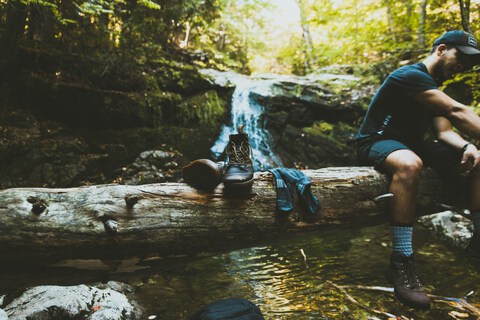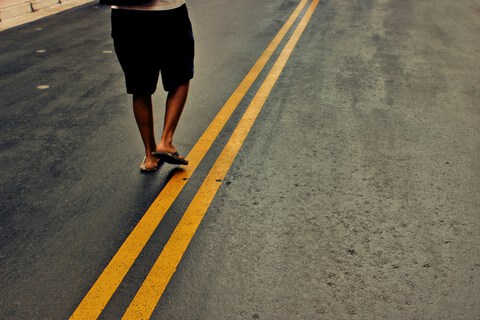Take care of your feet
Discover essential daily foot care tips for the Camino. Simple tips on how to wash, inspect, and care for your feet after each day's walk and prevent blisters.
Keep on walking
The camino demands a lot from your feet. Given the long distances involved, proper foot care becomes not just beneficial but essential. Here’s a comprehensive guide to keeping your feet healthy and happy throughout your pilgrimage.
Choose the right footwear
The foundation of good foot care on the Camino starts with selecting the right boots or shoes. It’s crucial that your footwear fits well—not too tight to cause blisters, and not too loose to create friction. Look for shoes that offer good support and are designed for the type of terrain you’ll encounter. It’s advisable to buy your footwear well in advance of your trip and spend significant time breaking them in. This means wearing them on multiple preparatory hikes to ensure they mold to the shape of your feet comfortably.
Invest in quality socks
Pairing your boots with the right socks can significantly impact your comfort. Moisture-wicking socks are ideal as they help keep feet dry, reducing the risk of blisters. Some pilgrims prefer merino wool socks for their ability to regulate temperature and resist odor, while others opt for synthetic blends for their quick-drying properties. Consider carrying a few pairs and rotating them daily to maintain foot hygiene.

Care for your feet, and they will carry you to the end of the earth.
Blister prevention and care
Blisters are one of the most common foot ailments on the Camino. To prevent them, apply anti-blister balms or tapes to known hot spots on your feet before you start your day’s walk. If you do develop a blister, it’s important to manage it properly. Clean the area and use a sterile needle to drain it if necessary, then cover it with a blister plaster or medical tape. Always carry a small foot care kit including sterile wipes, plasters, and anti-blister treatments.
Daily foot care routine
Maintaining a daily foot care routine is essential during long walks like the Camino de Santiago, as it can significantly affect your comfort and ability to continue hiking without complications. Here’s how to effectively implement a daily foot care routine to ensure your feet stay healthy throughout your journey.
- Wash your feet
After a long day of walking, the first step is to wash your feet with soap and lukewarm water. This will help remove any dirt, sweat, and bacteria that have accumulated during the day. It’s important to clean gently between the toes and around the nails. After washing, thoroughly dry your feet, especially between the toes, to prevent fungal infections. - Inspect your feet
Look for any signs of blisters, redness, or irritation. Early detection of these issues is key to preventing them from becoming severe. Use a mirror if you can't see all parts of your feet clearly. Pay particular attention to areas where you have previously experienced discomfort. - Elevate your feet
Elevating your feet for 20 to 30 minutes can greatly reduce swelling and improve circulation, which is especially beneficial after a day of strenuous activity. This can be done by lying down and placing your feet on a pillow or rolled-up towel at a level higher than your heart. - Moisturize
Apply a good quality foot cream or moisturizer to keep your skin hydrated. Avoid moisturizing between the toes as this can encourage fungal growth. Focus on the heels and any areas where the skin tends to become dry and cracked. Moisturizing not only prevents cracking but also maintains the skin’s elasticity, reducing the risk of breaks and sores. - Wear breathable footwear
Once your feet are clean and moisturized, avoid putting your hiking boots back on immediately. Instead, wear sandals or open-toed shoes around the camp or hostel to allow your feet to breathe and dry out completely. This can also help reduce the risk of fungal infections. - Change into fresh socks
Before going to bed or whenever your feet are clean and dry, put on a fresh pair of socks. This helps keep your feet clean, dry, and warm overnight. Using socks made of materials that wick moisture away from the skin can be particularly beneficial. - Perform gentle foot exercises
Before going to bed, consider doing gentle foot stretches or exercises. This can help alleviate tightness in the foot muscles and tendons, promoting better circulation and reducing the risk of injuries the next day. Simple toe curls, ankle rotations, and flexing the foot forward and backward can be quite effective.

Flip-flops: a pilgrim's best friend after a long day on the trail.
Seek professional help when needed
While many minor foot problems can be treated with first aid, don’t hesitate to seek professional help if the issue persists or worsens. Larger towns along the Camino route often have podiatrists or medical clinics where you can receive treatment. Listening to your body and addressing foot concerns promptly can prevent more serious complications and help ensure that you can continue your pilgrimage comfortably.
By taking these steps to care for your feet, you’ll greatly enhance your experience on the Camino de Santiago. Remember, your feet are your most valuable asset on this journey, and taking good care of them is key to enjoying and completing your pilgrimage. Whether you’re walking the classic French Way or exploring less traveled routes, proper foot care is your passport to a successful Camino experience.
Community newsletter
Subscribe to our monthly newsletter and as a warm welcome, we'll gift you the Camino packinglist and the Camino 12-step guide for free. We can't wait to share this journey with you!